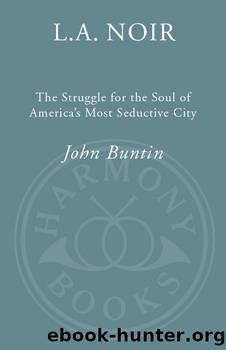L.a. noir: the struggle for the soul of america's most seductive city by John Buntin

Author:John Buntin [John Buntin]
Language: eng
Format: epub
Tags: Policier
ISBN: 9780307352071
Published: 2009-08-25T08:07:51+00:00
FOR DECADES, police departments had enjoyed wide latitude in how they went about apprehending criminal suspects. In 1914, the U.S. Supreme Court had ruled that evidence improperly or illegally obtained could not be used at trialâa principle known today as the exclusionary rule. But the exclusionary rule applied only to federal law enforcement agencies. For local law enforcement, the proof was in the pudding. If the evidence was incriminating, courts typically asked few questions about how it was obtained. Only the most flagrant examples of police misconduct could bestir most judges to exclude evidence. The result was corner-cutting. Civil liberties advocate Hugh Manes would later note that between 1931 and 1962, the LAPD served only 631 search warrants, about 20 a year, a shockingly low number. Police routinely responded to truly serious crimes by throwing dragnets around entire neighborhoods and âtossingâ hotels, motels, and even private homes in search of potential suspects. Yet in its 1949 decision Wolf v. Colorado, the court reiterated its opinion that the exclusionary rule did not apply to local law enforcement agencies.
Of course, not every method was legal. Federal statutes prohibited wiretapping, as did California state law. The prohibition was absolute: No provision was provided for law enforcement agencies to seek court permission to tap a phone line. Parker understandably viewed this as a major problem. But the department did have a work-around; it simply broke into peopleâs homes and businesses and installed dictographs. The police department reasoned that since these were stand-alone recording devices that did not involve âtappingâ a phone line, they were legal, end of story. The courts agreedâuntil November 1953, when the U.S. Supreme Court took up the case of Irvine v. California.
The case involved a suspected bookmaker (Irvine) whoâd been targeted by the Long Beach Police Department. Officers had brought in a locksmith to make copies of the manâs house keys, entered his house, and then installed a dictograph in his bedroom closetâall without a search warrant. The evidence obtained from the âbugâ was the basis of the manâs subsequent conviction. During his first trial in state court, the bookmaker had argued that by breaking into his house without a warrant, police had violated his Fourth Amendment rights to be safe from unreasonable search and seizure. The state court disagreed, as did the state appeals court. So Irvine petitioned the U.S. Supreme Court to take the case, successfully.
On February 8, 1954, the Supreme Court handed down its ruling. It noted that repeatedly entering the petitionerâs home without a warrant âwas a trespass and probably a burglary.â The majority opinion described dictographs as âfrightening instruments of surveillance and invasion of privacy, whether [used] by the policeman, the blackmailer, or the busybody.
âThat officers of the law would break and enter a home, secrete such a device, even in a bedroom, and listen to the conversation of the occupants for over a month would be almost incredible if it were not admitted,â the majority continued. âFew police measures have come to our attention
Download
This site does not store any files on its server. We only index and link to content provided by other sites. Please contact the content providers to delete copyright contents if any and email us, we'll remove relevant links or contents immediately.
| Espionage | Hoaxes & Deceptions |
| Murder & Mayhem | Organized Crime |
| Serial Killers | White Collar Crime |
Mindhunter: Inside the FBI's Elite Serial Crime Unit by John E. Douglas & Mark Olshaker(9206)
Wiseguy by Nicholas Pileggi(5674)
Room 212 by Kate Stewart(5040)
Hitman by Howie Carr(5022)
Secrecy World by Jake Bernstein(4651)
Killers of the Flower Moon: The Osage Murders and the Birth of the FBI by David Grann(4387)
Papillon (English) by Henri Charrière(4199)
Breaking Free by Rachel Jeffs(4175)
Killers of the Flower Moon by David Grann(3971)
Say Nothing by Patrick Radden Keefe(3903)
American Kingpin by Nick Bilton(3759)
The Secret Barrister by The Secret Barrister(3615)
Molly's Game: From Hollywood's Elite to Wall Street's Billionaire Boys Club, My High-Stakes Adventure in the World of Underground Poker by Molly Bloom(3486)
Mysteries by Colin Wilson(3397)
In Cold Blood by Truman Capote(3311)
Signature in the Cell: DNA and the Evidence for Intelligent Design by Stephen C. Meyer(3075)
I'll Be Gone in the Dark by Michelle McNamara(3024)
Rogue Trader by Leeson Nick(2977)
Bunk by Kevin Young(2950)
